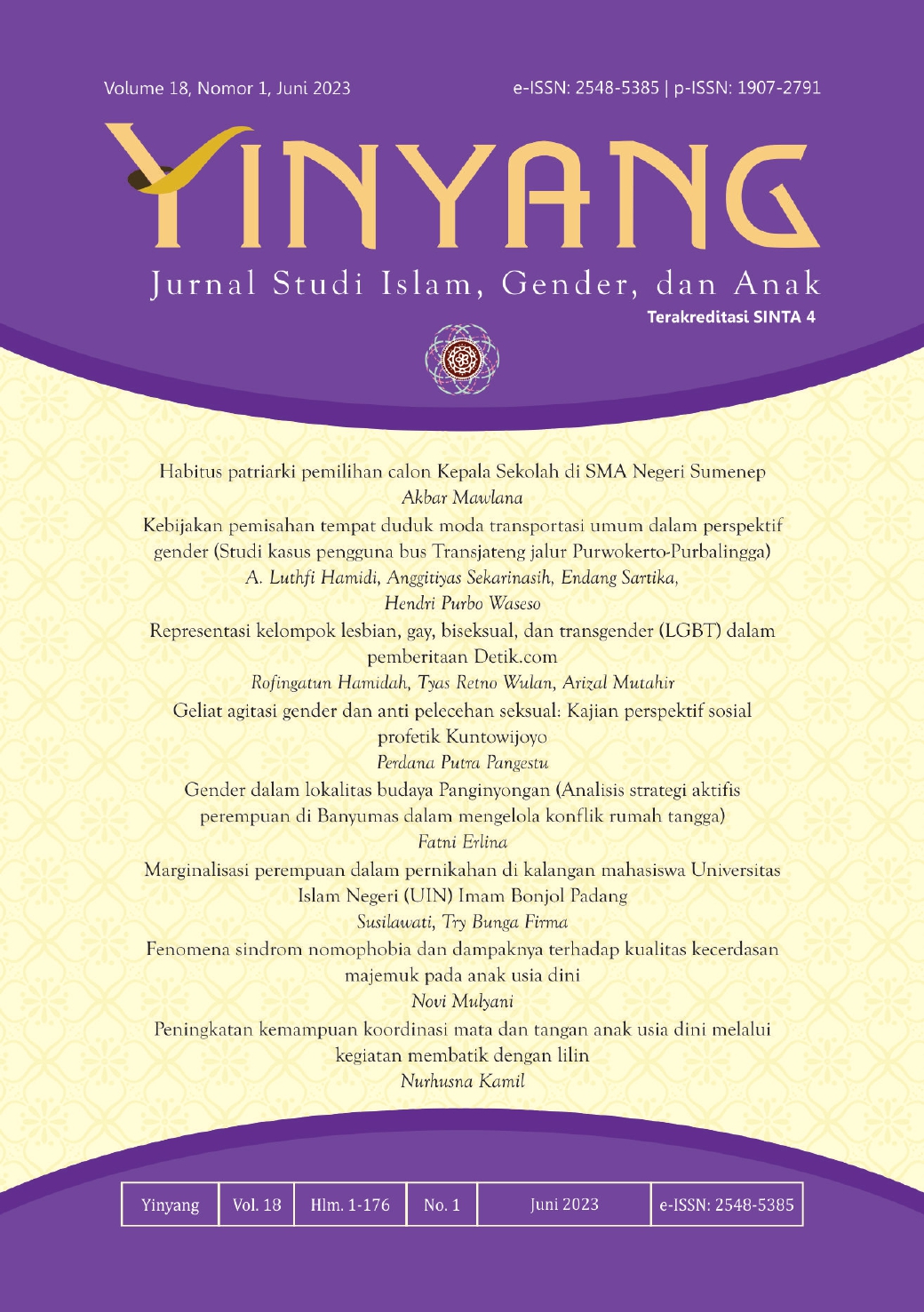Gender dalam lokalitas budaya Panginyongan (Analisis strategi aktifis perempuan di Banyumas dalam mengelola konflik rumah tangga)
DOI:
https://doi.org/10.24090/yinyang.v18i1.7087Keywords:
Gender, Panginyongan, Conflict, Role, HouseholdAbstract
This article aims to find out how the locality value of panginyongan is implemented in Banyumasan culture, through a strategy for managing household role conflicts. The women activists who are active in public spaces, consciously have a dual role, but which factors are the most significant in supporting their harmony are not necessarily understood, so there has been no effort to maintain their existence. This article is a field study that takes a sample of women activists in Banyumas. The process of extracting data is carried out by means of in-depth interviews to determine the gender perception index, then using focus group discussions (FGD) to find out how the informants internalize the Panginyongan cultural values in their lives, especially related to the division of household roles. With the point of view of the subjects studied, the research is expected to produce a thick description of the strategy for managing household role conflicts through the cultural values of panginyongan. The results showed that the equality of positions had permeated through the equivalence of language, speech, attitude and behavior, so that none of the household players felt humiliated or exalted in filling domestic or public duties. If the wife is left for outdoor activities, the husband plays a role in completing the abandoned domestic work, and vice versa.Downloads
References
Dadan, S. (2019). Ekspresi Bahasa Banyumasan Dalam Kaus Oblong Sebagai Arena Kontestasi Budaya. Seminar Internasional Riksa Bahasa XIII (pp. 2053-2062). Bandung: UPI.
Faiz, M. F. (2015). Teori Hermeneutika Al-Qur’an Nashr Hamid Abu Zayd Dan Aplikasinya Terhadap Wacana Gender Dalam Studi Hukum Islam Kontemporer. Al-Ahwal, 23-62.
Hutagalung, D. (2004). Hegemoni, Kekuasan dan Ideologi. Diponegoro 74: Jurnal Pemikiran Sosial, Politik dan Hak Asasi Manusia, 1-18.
Intan, H. S. (2014). Kedudukan Perempuan Dalam Domestik Dan Publik Perspektif Jender (Suatu Analisis Berdasarkan Normatifisme Islam). Jurnal Politik Profetik, 1-16.
Janah, N. (2017). Telaah Buku Argumentasi Kesetaraan Gender Perspektif Al-Quran Karya Nasaruddin Umar. Sawwa: Jurnal Studi Gender, 167-182.
Komarudin, O. (2014). Kritik terhadap Kurikulum Berbasis Kesetaraan Gender. Jurnal At-Ta’dib, 127-142.
Marhaeni, A. A. (2008). Perkembangan Studi Perempuan, Kritik, Dan Gagasan Sebuah Perspektif Untuk Studi Gender Ke Depan. Jurnal Kependudukan dan Sumber Daya Manusia, 1-29.
Nugroho, S. (2016). Praktik Geowisata Karangsambung Kebumen: Tinjauan Perspektif Dualitas. Jumpa: Jurnal Master Pariwisata, 92-114.
Pratomo, A. R. (2018). Ngapak dan Identitas Banyumasan (Komunikasi Organisasi Berbasis Dialek Budaya Lokal di Dinas Pendidikan dan Unit Pendidikan Kecamatan (UPK) Banyumas). Yogyakarta: UII.
Samsidar. (2019). Peran Ganda Wanita dalam Rumah Tangga. An Nisa’, 655.
Santoso, E. (2017). Kontestasi Identitas di Media Sosial (Diskursus tentang Karakter dan Bahasa Banyumas di Weblog, Twitter dan Facebook). Prosiding Konferensi Nasional Komunikasi (pp. 763-775). Jakarta: ISKI (Ikatan Sarjana Komunikasi Indonesia).
Sapitri, E. (2017). Pembagian Peran Antara Suami Isteri Dan Implikasinya Terhadap Keharmonisan Keluarga (Studi Kasus di Gampong Lawe Cimanok Kecamatan Kluet Timur Kabupaten Aceh Selatan). Aceh: UIN Ar-Raniry.
Umar, N. (2010). Argumentasi Kesetaraan Jender Perspektif Al-Qur’an. Jakarta: Paramadina.
Wiasti, N. M. (2017). Mencermati Permasalahan Gender dan Pengarusutamaan Gender (PUG). Sunari Penjor: Journal of Anthropology, 37.
Zubaedah, S. (2010). Mengurai Problematika Gender dan Agama. Yinyang Jurnal Studi Gender & Anak, 243-260.
Downloads
Published
How to Cite
Issue
Section
License
Copyright (c) 2023 Fatni Erlina

This work is licensed under a Creative Commons Attribution-ShareAlike 4.0 International License.
Authors who publish with this journal agree to the following terms: Authors retain copyright and grant the journal right of first publication with the work simultaneously licensed under a Creative Commons Attribution-ShareAlike 4.0 International License that allows others to share the work with an acknowledgment of the work's authorship and initial publication in this journal.

















